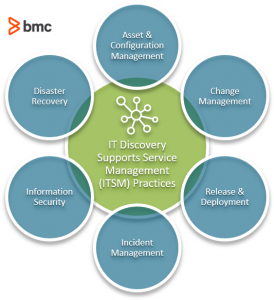Introduction To IT Discovery


Today’s IT organizations continue to grapple with the twin challenges of evolving to keep up with changing customer and technology needs while maintaining stability on existing services in the face of disruptions and risks.
For this reason, visibility into IT components. including their interconnections and dependencies, has become a key differentiator in successful service management practices. Without visibility, there is a real risk of business loss and dissatisfaction in the services you deliver to customers.
While IT discovery may seem like a piece of cake for smaller organizations, larger enterprises are finding this to be a challenge. This has been exacerbated by the following drivers:
IT discovery is the process of identifying and collecting data on existing IT components within a network.
This involves carrying out a sweep across the network using IT tools to find all the IT assets within the specified environment including hardware, software, virtual instances, cloud components, and smart devices, among others.
The kind of information that can be gathered during a discovery includes:
Discovery allows us to take a snapshot of IT components or environment—their current state. This facilitates capturing of baseline information that can be used to support other ITSM practices, including:

Discovery is an important tool during audits of IT assets. You might unearth discrepancies between asset records held by Finance and those maintained by IT, especially where the status information is inconsistent e.g. devices that are not in use, lost, or out of service.
Discovery can also unearth devices that are using unlicensed software or incorrectly configured, which can cost the organization from a cost or effectiveness perspective.
(Learn more about asset management & configuration management.)
Technical teams reviewing changes to determine potential impact on other services and components can leverage insights provided by IT discovery data. Such insights can:
(Know types & levels of change management.)
Discovery can aid in planning of releases, as visibility into whether dependencies such as libraries and OS versions can be determined in advance and validated before installation of new or updated software components in the IT environment.
Discovery can also be employed during post-verification checks after deployment activities.
(Compare deployment to release.)
Investigations into incident causes can be aided by discovery information, as information on service and component configuration, status, and dependency can be very valuable for technical teams involved in resolution efforts.
(See how incident management should work.)
Discovery can be useful in mobile device management particularly in identifying and managing BYOD where data breach risks abound from personal owned devices accessing business and customer information.
Discovery is also a key capability used for identifying access points when enumerating a network for purposes of penetration testing.
(Explore information security, which starts with asset discovery.)
Following a major disruption that might require an organization to restore its services in a different IT environment, information from discovery can prove an invaluable resource in rebuilding IT services and components from scratch.
(Plan for disaster with these best practices.)
At the most basic level, discovery of active IT devices on a network can take place through Address Resolution Protocol (ARP) commands. The ARP cache contains one or more tables that are used to store IP addresses and their resolved Ethernet or Token Ring physical addresses. ARP works for IPv4, but has since been replaced by Neighbor Discovery (ND) for IPv6 devices, which works in a similar fashion.
Beyond ARP, SNMP (Simple Network Management Protocol) is the next level of discovery. Devices that are configured for SNMP can respond to messages called protocol data units (PDUs) from devices within the same network segment. The discovery tool will send an SNMP GET message requesting for information from other devices that are SNMP enabled. The information is stored in Management Information Bases (MIBs) that contain configuration and status information.
Other approaches for IT discovery include:
Specialized IT discovery tools are able to process the information in MIBs and create topologies of network architecture as well as display status of various network elements. These tools can be triggered via manual action or configured to automatically search and update asset information. A common distinction in how these tools work is the agent vs agentless approach:
IT discovery shouldn’t be treated as just an exercise to turn on a tool, let it gather data, and that’s it. It is critical that you define a discovery process that ensures collected information is both:
Value can only be generated from IT discovery if it supports the ITSM practices mentioned earlier, leading to better managed services, cost effectiveness, and overall business success.